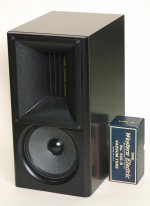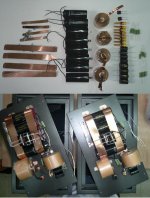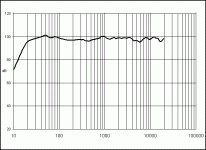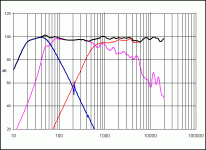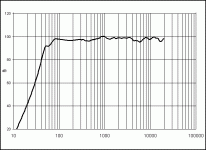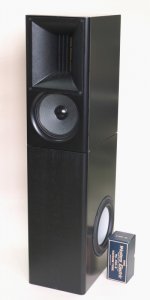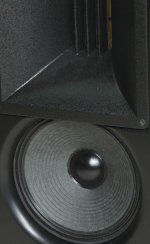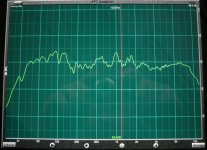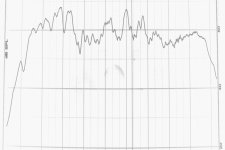One big horn ribbon
+ one 8" carbon composite hi eff driver
+ 30L mixed composite cabinet (baffle plate solid wood, sides and back laminar, top/bottom NZ mdf) to kill resonance
+ all film cap and oil paper copper foil inductors
+ physically time align the drivers
+ crossover 1st order at 600hz
= 100db/w in room or 98db/2.83v/1m with a very pretty response 65hz to 25khz, 8 ohm impedance
We will sell this as a kit hopefully with the front baffle plate as that is difficult part. Getting prices on that now.
Cabinet is 19.5" (50cm) tall x 10" (26cm) w x 14" (36cm) deep
Hoffman rusts?
+ one 8" carbon composite hi eff driver
+ 30L mixed composite cabinet (baffle plate solid wood, sides and back laminar, top/bottom NZ mdf) to kill resonance
+ all film cap and oil paper copper foil inductors
+ physically time align the drivers
+ crossover 1st order at 600hz
= 100db/w in room or 98db/2.83v/1m with a very pretty response 65hz to 25khz, 8 ohm impedance
We will sell this as a kit hopefully with the front baffle plate as that is difficult part. Getting prices on that now.
Cabinet is 19.5" (50cm) tall x 10" (26cm) w x 14" (36cm) deep
Hoffman rusts?
Attachments
Last edited:
Looks interesting!
There's no reflections or anything off the bottom of that horn (from the cone), or since the crossover is relatively low, I'm assuming they're insignificant at those wavelengths?
I know price is TBD, but are we talking 500/pair, 1000/pair, 1500/pair, in those sorts of ranges?
There's no reflections or anything off the bottom of that horn (from the cone), or since the crossover is relatively low, I'm assuming they're insignificant at those wavelengths?
I know price is TBD, but are we talking 500/pair, 1000/pair, 1500/pair, in those sorts of ranges?
The Crescendo Crossover
Our horn ribbon crosses over in the 600hz region. Such a crossover requires big caps but we don't want to pollute the purity and transparency of this awesome ribbon by using electrolytics.
As shown, this is an all-film cap deal, retained with pure copper straps (non magnetic and good damping). Part of the recipe also calls for the tinfoil and silver mica caps shown to capture that elusive 'sheen' quality that is usually only heard in live performance of strings, cymbals and voices.
Add to this silver wire, pure copper binding posts and carbon film resistors.
The inductors are our own, made with imported oil paper and copper foil and of course air-cored.
Just wanted you to see. These kind of ingredients would be at home in a 50K$ system.
Crescendo -- bringing it home, alive.
Our horn ribbon crosses over in the 600hz region. Such a crossover requires big caps but we don't want to pollute the purity and transparency of this awesome ribbon by using electrolytics.
As shown, this is an all-film cap deal, retained with pure copper straps (non magnetic and good damping). Part of the recipe also calls for the tinfoil and silver mica caps shown to capture that elusive 'sheen' quality that is usually only heard in live performance of strings, cymbals and voices.
Add to this silver wire, pure copper binding posts and carbon film resistors.
The inductors are our own, made with imported oil paper and copper foil and of course air-cored.
Just wanted you to see. These kind of ingredients would be at home in a 50K$ system.
Crescendo -- bringing it home, alive.
Attachments
Looks interesting!
There's no reflections or anything off the bottom of that horn (from the cone), or since the crossover is relatively low, I'm assuming they're insignificant at those wavelengths?
I know price is TBD, but are we talking 500/pair, 1000/pair, 1500/pair, in those sorts of ranges?
Yes, you nailed it. The crossover is low so reflections aren't an issue. The advantage of that alignment is the woofer flange is mounted from the inside in a flared opening which allows for time alignment with the horn.
As soon as we installed the drivers in this configuration we heard more coherence and seamless blending of the drivers.
Price: I have to sit down with a calculator and see where we've landed with all this. We haven't held back in any way with quality parts so it will be in the upper range of your stated numbers.
regards
Brian
Brian
Tell us something about how these sound and maybe some comparisons with other commercial speakers to give a benchmark. (I know you have a vested interest here but try to be objective!)
You probably know what a good ribbon sounds like? Basically like that except much bigger and much lower into the midrange since the ribbon itself is huge.
I guess most reminds of good quality electrostatic except with scary dynamics. High frequencies are very pure and transparent.
Matching that sound (and the efficiency) in lower mid/bass was the challenge and is accomplished with the 8" cone.
I can't really think of another speaker with similar sound except maybe the Avantgarde Uno (original and only when well setup).
regards
Brian
Please consider selling the Horn Ribbon as a component for DIY'ers!
Hi Brian,
Your new speaker looks very interesting. However, I would assume that especially your newly developed Horn Ribbon would be very interesting as a component/spare part for DIY'ers. Therefore, PLEASE consider offering the Horn Ribbon as a single component
One question regarding the Horn Ribbon: Is it as fragile as many "hifi" ribbons, or could it for instanse be used in an active setup connected directly (with no caps) to an amplifier?
I ask, because I have a fully horn loaded rig and being tired of compression drivers I would love to use a driver like the Horn Ribbon in my active setup
Please keep us posted on forther developments - thanks a lot!
Best regards
Peter
Hi Brian,
Your new speaker looks very interesting. However, I would assume that especially your newly developed Horn Ribbon would be very interesting as a component/spare part for DIY'ers. Therefore, PLEASE consider offering the Horn Ribbon as a single component
One question regarding the Horn Ribbon: Is it as fragile as many "hifi" ribbons, or could it for instanse be used in an active setup connected directly (with no caps) to an amplifier?
I ask, because I have a fully horn loaded rig and being tired of compression drivers I would love to use a driver like the Horn Ribbon in my active setup
Please keep us posted on forther developments - thanks a lot!
Best regards
Peter
Crescendo Drivers, Crossover and Cabinets
Each of the parts making up the Crescendo Speaker system have been selected to be outstanding in concept and quality. Yet by careful design we have achieved a whole that is more than the already considerable sum of the parts.
Offering 100dB/2.83V/1m sensitivity in room (106db/2.83V/1m if we account for the fact that we use a stereo pair of speakers) the Crescendo is the highest efficiency speaker available from Diyhifisupply and it combines this with also some of the highest practical power handling and dynamic range.
Successfully blending a hornloaded and high efficiency HF system with a cone midrange is a challenge, finding a midrange that can match the electrostatic like clarity of a Ribbon Driver such as used in the Crescendo is even harder. Then bridging the gap to a Subwoofer is another challenge.
We needed to create the perfect combination of Drivers, Enclosure and Crossover to achieve the kind of performance the Crescendo offers.
The Crescendo Standmounting speaker was designed to offer the highest possible sound quality and high efficiency from a compact speaker. The Crescendo was designed mainly with the aim of partnering low powered valve amplifiers, however due to the exceptionally well controlled directivity an application in home cinemas is also possible.
The only limiting fact that was accepted from the beginning was that the speaker would be aimed at providing an 70Hz lower frequency limit to be used with either the dedicated Stand/Subwoofer of our own design or with any high quality commercial subwoofer system.
Crescendo LF Driver
--------------------------------
The Crescendo low frequency driver is a 8" driver combining an oversized massive 5.5" diameter vented magnet system and cast frame, to avoid resonances and lack of precision induced by using stamped steel frames. The cone surface is about the same as that of two common 6.5" HiFi drivers, yet reserved only for midrange and upper bass.
In order to allow for a light but sufficiently stiff cone the Crescendo LF driver uses a carbon fiber matrix reinforced paper cone with a dustcap made from lacquer impregnated cloth. The surround is formed by double roll lacquer impregnated cloth.
With a 1.5" Voice coil and a very light cone (19.5g which is only a little more than the 14.7g for Lowther drivers!) the Crescendo LF driver shares much with the high efficiency full range drivers that have become fashionable in recent years. It offers a similar combination of a strong motor, light cone and large surface area provide a perceived "speed" sufficient to match the Ribbon/Horn assembly used for the high frequencies. Yet by designing a driver that strictly aims at the lower midrange and upper bass, rather than attempting to produce a fullrange driver the performance can be maximised for the desired frequency range, without having to be compromised in the interest of high frequency reproduction.
Crescendo LF Enclosure
-----------------------------------
The Crescendo enclosure are modified GHP enclosures originating and somewhat common in the German audio scene. This combines in our case a vented enclosure with a precisely adjusted RC circuit in series with the driver. This RC circuit alters the tuning and driver phase in band to produce more low frequency sound pressure in the desired band and acts as excursion limiter for the Crescendo LF Driver below the range it is meant to handle.
This enclosure is not the commonly used vented box with series high-pass capacitor (which produces significant frequency response peaks before the roll-off and often fails to protect the driver from large excursions) but a more advanced system that allows the maximum SPL (at the limits of Hoffmans "iron law") and bandwidth as well as a smooth integration with Subwoofers.
The resulting Systems with the Crescendo LF Driver offers a tuning to 60Hz (minimum movement point of the driver) with a -3dB Point of 70Hz and 98dB/2.83V in half space and a realistic SPL of 100dB/2.83V inside an enclosed space such as a listening room. Overall cone-movement is controlled very well and is held below X-Max at all frequencies up to around 25 Watt input power.
For use with much higher power levels (e.g. Home Theater) using "Bass Management" with the speakers set to "small" is recommended.
Crescendo HF Driver
--------------------------------
We use an quite extraordinary magnetostat ribbon with a surface area twice as large as the surface area of a 3" midrange dome, yet with a frequency response up to 25KHz, coupled to an exponential waveguide (horn). This unit is derived from ribbons for professional sound reinforcement duties with huge SPL capabilities thanks to horn loading and high power handling. Using it in a HiFi speaker means the driver is very much underexploited, which repays with low distortion and a freedom from compression. It also allows us to use a very low crossover frequency (600Hz) and low order crossover (1st order or 6dB/Octave) without concerns of damage to the driver or acoustically overloading the ribbon driver.
The Crescendo HF driver combines a cast aluminum 60 by 20 degrees waveguide and a cast aluminum rear chamber with neodymium magnets and a kapton diaphragm to produce a high frequency unit without parallel. Covering 600Hz - 25KHz (+/-3dB) with a real 100dB/2.83V/1m and 6 Ohm impedance it is the ultimate driver for the upper midrange well into the ultrasonic range.
The controlled and narrow dispersion means that more of the sound from the recording is radiated towards the listener and less towards the floor, ceiling and other walls, where they would cause reflections and conflicting spatial cues. This directness of sound radiation with it's freedom from room sound clutter helps producing a more holographic sound-field than most speakers, even in room situations that are less than ideal for music reproduction (modern style living rooms for example).
Crescendo Crossover
--------------------------------
The Crescendo crossover combines extreme simplicity with the highest quality possible. The crossover between the Crescendo HF Ribbon/Horn combo and the Crescendo LF section is at 600Hz with first order slopes.
The Crescendo HF Driver is fed though a Obbligato Oil Capacitor with a small amount of attenuation to match the SPL of the Crescendo LF Driver implemented using Kiwame carbon resistors in series with the capacitor. A set of Obbligato Tinfoil Capacitors with a Silver/Mica bypass capacitor act as "speedup" capacitors, connecting directly to the Crescendo HF Driver and binding posts, bypassing the Obbligato Oil Capacitor and the attenuation for very high frequencies.
The Crescendo LF Driver uses the RC low frequency tuning network described in the enclosure section. This is realised with three Obbligato Polypropylene Film Capacitors (100uF/400V) and Kiwame resistors.
The lowpass is realised using our own copper-foil & oiled paper inductors. A further copper foil choke is used for a antiresonance RLC circuit which corrects the drivers impedance and frequency response in the crossover region.
This is it. As minimal as possible with no attenuation and only minimal equalisation to avoid sucking the efficiency and life out of the speaker , yet at a level of parts quality only found in the most esotheric High End designs.
Crescendo Subwoofer
-------------------------------
The Crescendo subwoofer was designed to match the SPL produced by the Crescendo main module when driven by normal Amplifiers up to around 15 Watt. This covers most single ended tube amplifiers. For Home Theater use or when using high power tube amplifiers it is recommended to utilise two Crescendo Subwoofers (one above and one below the Crescendo Satellite) to gain extra SPL capabilities, to keep step with the high efficiency of the main module.
Subwoofer Driver
-------------------------------
The driver in the Subwoofer we designed to match the Crescondo main module uses our long standing Dynafone Driver. This subwoofer driver was designed ground-up with the aim to support high efficiency speakers in the low bass AND work in small cabinets due to the specified low VAS (~30L).
The Dynafone Drivers uses a double stack if 5.5" diameter magnets to produce a strong motor. A cast frame is mandatory given the forces generated when the cone is forced to great excursions. The 2" Diameter voice coil is wound on a aluminum voice coil former to allow greater power handling. A double-spider system is used to ensure the cone movement remains linear even at high excursions.
The diaphragm is an inverted dome made from aluminum and coated with a special oxide to damp the internal resonances of the aluminum diaphragm. The result is a woofer that can play up to beyond 1KHz without resonances and falls off smoothly past that.
Subwoofer Enclosure
-------------------------------
The Crescendo Subwoofer uses a Mass Loaded Transmission Line Enclosure (MLTL). This is a modification on the traditional transmission line enclosure that combined the quarterwave resonance of the transmission line with a special loading system that tunes the line to a much lower frequency than that of a traditional Transmission line of the same length.
This allows a compact enclosure tuned to 25Hz with considerable gains in LF extension and output at very low frequencies compared to sealed boxes, yet without the usual compression, port chuffing at high volumes and boomy bass that characterises common reflex enclosures.
When combined with the active crossover required for the Crescendo (4th order lowpass at 50Hz) the bandwidth of the system is 20Hz - 60Hz (-3dB points). The maximum power handling is 250W/8Ohm down to 25Hz while remaining within the linear capabilities of the Dynafone Driver. However, the system is able to safely handle over 500W without damage.
Subwoofer Amplifier/Crossover
----------------------------------------------
The Crescendo Subwoofer is driven by the Reckhorn A1000. The A1000 combines an adjustable 4th order lowpass crossover with a 800W Class D Mono Poweramplifier. It is the kind of "powerhouse" Amplifier that seems to deliver limitless power that is really ideal for power hungry subwoofer applications.
In the Crescendo system it provides 400W to one Crescendo Subwoofer, or 600W to a pair of Crescendo Subwoofers.
This translates into around 114dB/1m at 30Hz (inside a room) for a single Crescendo Subwoofer when driven hard.
Using two in a stereo pair with a pair of Reckhorn A1000 Amplifiers as would be common with the crescendo system, a pair of Crescendo Subwoofers can produce 120dB/1m at 30Hz.
If two pairs of subwoofers are employed with two Reckhorn A1000 Amplifiers theoretically an SPL of 125dB/1m at 30Hz can be attained.
This is more than enough to keep up will with the Crescendo Main Module.
Each of the parts making up the Crescendo Speaker system have been selected to be outstanding in concept and quality. Yet by careful design we have achieved a whole that is more than the already considerable sum of the parts.
Offering 100dB/2.83V/1m sensitivity in room (106db/2.83V/1m if we account for the fact that we use a stereo pair of speakers) the Crescendo is the highest efficiency speaker available from Diyhifisupply and it combines this with also some of the highest practical power handling and dynamic range.
Successfully blending a hornloaded and high efficiency HF system with a cone midrange is a challenge, finding a midrange that can match the electrostatic like clarity of a Ribbon Driver such as used in the Crescendo is even harder. Then bridging the gap to a Subwoofer is another challenge.
We needed to create the perfect combination of Drivers, Enclosure and Crossover to achieve the kind of performance the Crescendo offers.
The Crescendo Standmounting speaker was designed to offer the highest possible sound quality and high efficiency from a compact speaker. The Crescendo was designed mainly with the aim of partnering low powered valve amplifiers, however due to the exceptionally well controlled directivity an application in home cinemas is also possible.
The only limiting fact that was accepted from the beginning was that the speaker would be aimed at providing an 70Hz lower frequency limit to be used with either the dedicated Stand/Subwoofer of our own design or with any high quality commercial subwoofer system.
Crescendo LF Driver
--------------------------------
The Crescendo low frequency driver is a 8" driver combining an oversized massive 5.5" diameter vented magnet system and cast frame, to avoid resonances and lack of precision induced by using stamped steel frames. The cone surface is about the same as that of two common 6.5" HiFi drivers, yet reserved only for midrange and upper bass.
In order to allow for a light but sufficiently stiff cone the Crescendo LF driver uses a carbon fiber matrix reinforced paper cone with a dustcap made from lacquer impregnated cloth. The surround is formed by double roll lacquer impregnated cloth.
With a 1.5" Voice coil and a very light cone (19.5g which is only a little more than the 14.7g for Lowther drivers!) the Crescendo LF driver shares much with the high efficiency full range drivers that have become fashionable in recent years. It offers a similar combination of a strong motor, light cone and large surface area provide a perceived "speed" sufficient to match the Ribbon/Horn assembly used for the high frequencies. Yet by designing a driver that strictly aims at the lower midrange and upper bass, rather than attempting to produce a fullrange driver the performance can be maximised for the desired frequency range, without having to be compromised in the interest of high frequency reproduction.
Crescendo LF Enclosure
-----------------------------------
The Crescendo enclosure are modified GHP enclosures originating and somewhat common in the German audio scene. This combines in our case a vented enclosure with a precisely adjusted RC circuit in series with the driver. This RC circuit alters the tuning and driver phase in band to produce more low frequency sound pressure in the desired band and acts as excursion limiter for the Crescendo LF Driver below the range it is meant to handle.
This enclosure is not the commonly used vented box with series high-pass capacitor (which produces significant frequency response peaks before the roll-off and often fails to protect the driver from large excursions) but a more advanced system that allows the maximum SPL (at the limits of Hoffmans "iron law") and bandwidth as well as a smooth integration with Subwoofers.
The resulting Systems with the Crescendo LF Driver offers a tuning to 60Hz (minimum movement point of the driver) with a -3dB Point of 70Hz and 98dB/2.83V in half space and a realistic SPL of 100dB/2.83V inside an enclosed space such as a listening room. Overall cone-movement is controlled very well and is held below X-Max at all frequencies up to around 25 Watt input power.
For use with much higher power levels (e.g. Home Theater) using "Bass Management" with the speakers set to "small" is recommended.
Crescendo HF Driver
--------------------------------
We use an quite extraordinary magnetostat ribbon with a surface area twice as large as the surface area of a 3" midrange dome, yet with a frequency response up to 25KHz, coupled to an exponential waveguide (horn). This unit is derived from ribbons for professional sound reinforcement duties with huge SPL capabilities thanks to horn loading and high power handling. Using it in a HiFi speaker means the driver is very much underexploited, which repays with low distortion and a freedom from compression. It also allows us to use a very low crossover frequency (600Hz) and low order crossover (1st order or 6dB/Octave) without concerns of damage to the driver or acoustically overloading the ribbon driver.
The Crescendo HF driver combines a cast aluminum 60 by 20 degrees waveguide and a cast aluminum rear chamber with neodymium magnets and a kapton diaphragm to produce a high frequency unit without parallel. Covering 600Hz - 25KHz (+/-3dB) with a real 100dB/2.83V/1m and 6 Ohm impedance it is the ultimate driver for the upper midrange well into the ultrasonic range.
The controlled and narrow dispersion means that more of the sound from the recording is radiated towards the listener and less towards the floor, ceiling and other walls, where they would cause reflections and conflicting spatial cues. This directness of sound radiation with it's freedom from room sound clutter helps producing a more holographic sound-field than most speakers, even in room situations that are less than ideal for music reproduction (modern style living rooms for example).
Crescendo Crossover
--------------------------------
The Crescendo crossover combines extreme simplicity with the highest quality possible. The crossover between the Crescendo HF Ribbon/Horn combo and the Crescendo LF section is at 600Hz with first order slopes.
The Crescendo HF Driver is fed though a Obbligato Oil Capacitor with a small amount of attenuation to match the SPL of the Crescendo LF Driver implemented using Kiwame carbon resistors in series with the capacitor. A set of Obbligato Tinfoil Capacitors with a Silver/Mica bypass capacitor act as "speedup" capacitors, connecting directly to the Crescendo HF Driver and binding posts, bypassing the Obbligato Oil Capacitor and the attenuation for very high frequencies.
The Crescendo LF Driver uses the RC low frequency tuning network described in the enclosure section. This is realised with three Obbligato Polypropylene Film Capacitors (100uF/400V) and Kiwame resistors.
The lowpass is realised using our own copper-foil & oiled paper inductors. A further copper foil choke is used for a antiresonance RLC circuit which corrects the drivers impedance and frequency response in the crossover region.
This is it. As minimal as possible with no attenuation and only minimal equalisation to avoid sucking the efficiency and life out of the speaker , yet at a level of parts quality only found in the most esotheric High End designs.
Crescendo Subwoofer
-------------------------------
The Crescendo subwoofer was designed to match the SPL produced by the Crescendo main module when driven by normal Amplifiers up to around 15 Watt. This covers most single ended tube amplifiers. For Home Theater use or when using high power tube amplifiers it is recommended to utilise two Crescendo Subwoofers (one above and one below the Crescendo Satellite) to gain extra SPL capabilities, to keep step with the high efficiency of the main module.
Subwoofer Driver
-------------------------------
The driver in the Subwoofer we designed to match the Crescondo main module uses our long standing Dynafone Driver. This subwoofer driver was designed ground-up with the aim to support high efficiency speakers in the low bass AND work in small cabinets due to the specified low VAS (~30L).
The Dynafone Drivers uses a double stack if 5.5" diameter magnets to produce a strong motor. A cast frame is mandatory given the forces generated when the cone is forced to great excursions. The 2" Diameter voice coil is wound on a aluminum voice coil former to allow greater power handling. A double-spider system is used to ensure the cone movement remains linear even at high excursions.
The diaphragm is an inverted dome made from aluminum and coated with a special oxide to damp the internal resonances of the aluminum diaphragm. The result is a woofer that can play up to beyond 1KHz without resonances and falls off smoothly past that.
Subwoofer Enclosure
-------------------------------
The Crescendo Subwoofer uses a Mass Loaded Transmission Line Enclosure (MLTL). This is a modification on the traditional transmission line enclosure that combined the quarterwave resonance of the transmission line with a special loading system that tunes the line to a much lower frequency than that of a traditional Transmission line of the same length.
This allows a compact enclosure tuned to 25Hz with considerable gains in LF extension and output at very low frequencies compared to sealed boxes, yet without the usual compression, port chuffing at high volumes and boomy bass that characterises common reflex enclosures.
When combined with the active crossover required for the Crescendo (4th order lowpass at 50Hz) the bandwidth of the system is 20Hz - 60Hz (-3dB points). The maximum power handling is 250W/8Ohm down to 25Hz while remaining within the linear capabilities of the Dynafone Driver. However, the system is able to safely handle over 500W without damage.
Subwoofer Amplifier/Crossover
----------------------------------------------
The Crescendo Subwoofer is driven by the Reckhorn A1000. The A1000 combines an adjustable 4th order lowpass crossover with a 800W Class D Mono Poweramplifier. It is the kind of "powerhouse" Amplifier that seems to deliver limitless power that is really ideal for power hungry subwoofer applications.
In the Crescendo system it provides 400W to one Crescendo Subwoofer, or 600W to a pair of Crescendo Subwoofers.
This translates into around 114dB/1m at 30Hz (inside a room) for a single Crescendo Subwoofer when driven hard.
Using two in a stereo pair with a pair of Reckhorn A1000 Amplifiers as would be common with the crescendo system, a pair of Crescendo Subwoofers can produce 120dB/1m at 30Hz.
If two pairs of subwoofers are employed with two Reckhorn A1000 Amplifiers theoretically an SPL of 125dB/1m at 30Hz can be attained.
This is more than enough to keep up will with the Crescendo Main Module.
Attachments
Last edited:
Crescendo Grande, Hoffman and Heresy
The rule, no The Law is: efficiency, small cabinet, bass - pick any TWO.
So we've picked efficiency (100db) + small cabinet (~30L). Of course the drivers used are very special so even with our small cabinet we get down to about 65hz.
What can we do for the rest of the bass, down to 20hz or so? The only way to cheat The Law is to make up for the small cabinet with POWER and clever design.
So we have our compact MLTL cabinet with its special loading. We have the Dynafone which can put out really loud clean bass, handle loads of power (500w program) and be comfortable playing in 30L due to its low VAS.
But what about the POWER? The horn ribbon/cone section has a 10+ db headstart over most any compact bass driver. So 1w of sound from the Crescendo scales to about 10w to get the same sound from the bass unit. A 400w amp would be huge, until now. The Reckhorn sub amp puts out that 400w. A pair of them driving the Dynafone bass module can achieve in room spl of about 125db!
In case the idea of letting a digital amp into your system gives you the jitters: digital amp's one true home is in the bass. Just think, huge bass waveforms sampled into thousands of bits - what could be wrong?
So, the world's first small footprint 100db 20-25khz speaker system.
Heresy!
The rule, no The Law is: efficiency, small cabinet, bass - pick any TWO.
So we've picked efficiency (100db) + small cabinet (~30L). Of course the drivers used are very special so even with our small cabinet we get down to about 65hz.
What can we do for the rest of the bass, down to 20hz or so? The only way to cheat The Law is to make up for the small cabinet with POWER and clever design.
So we have our compact MLTL cabinet with its special loading. We have the Dynafone which can put out really loud clean bass, handle loads of power (500w program) and be comfortable playing in 30L due to its low VAS.
But what about the POWER? The horn ribbon/cone section has a 10+ db headstart over most any compact bass driver. So 1w of sound from the Crescendo scales to about 10w to get the same sound from the bass unit. A 400w amp would be huge, until now. The Reckhorn sub amp puts out that 400w. A pair of them driving the Dynafone bass module can achieve in room spl of about 125db!
In case the idea of letting a digital amp into your system gives you the jitters: digital amp's one true home is in the bass. Just think, huge bass waveforms sampled into thousands of bits - what could be wrong?
So, the world's first small footprint 100db 20-25khz speaker system.
Heresy!
Attachments
Crecendo: Customers Ask, "why the overbite"?
Why does the edge of the horn block part of the cone?
Why does the edge of the horn block part of the cone?
- First, the cone remains unobstructed. Only the surround is covered. Second, as the crossover frequency is at 600Hz the wavelength of the sound is around 57cm. Any obstruction that is much smaller than 1/4 of this essentially has no impact. The key is the distance between the horn acoustic center and that of the woofer. Due to the large size of both items the distance becomes quite large and approaches around halve the wavelength, so it needs to be minimised as much as possible to ensure correct integration between the drivers.
- Not at all. The chamfering both around the driver cutout and on the edges has no sonic impact whatsoever. With only 18mm radius chamfering it only has any impact above around 5KHz, as has the overlap.
- The crossover would require re-design if the distance is significantly altered.
- They cannot be pushed further apart, but then again, there is no interference to overcome, so there is no need to.
Attachments
Brian
Have you read Earl Geddes' theories about using 3 subs? Feedback from users is universely very favourable. It strikes me that your new speakers would make great candidates for the main speakers in such a set up. If I didn't already have a pair of Earl's Abbey front baffles on order I would seriously consider going that route.
Have you read Earl Geddes' theories about using 3 subs? Feedback from users is universely very favourable. It strikes me that your new speakers would make great candidates for the main speakers in such a set up. If I didn't already have a pair of Earl's Abbey front baffles on order I would seriously consider going that route.
Haven't, but would be interesting to try. The Crescendo can work with any sub configuration.Brian
Have you read Earl Geddes' theories about using 3 subs? Feedback from users is universely very favourable. It strikes me that your new speakers would make great candidates for the main speakers in such a set up. If I didn't already have a pair of Earl's Abbey front baffles on order I would seriously consider going that route.
regards
Brian
Hi Brian
Crescendo looks like a really nice design - lots of design time seems to have been invested. It might be helpful if more comments were available regarding their musical presentation.
Questions, relating to in-room use:
1. You mention controlled directivity in a previous post; do the ribbon and mid-bass driver have approximately matched directivity at the crossover point.
2. Related to question 1, are you able to provide plots or other information regarding the off-axis FR / power response?
3. In my room, speakers need to be positioned close to the front wall, 1-1.5 m from side walls, ~ 2 m apart, with me sitting ~ 2 m from each speaker; could the crescendi work in this arrangement?
I wish you all the best regarding this speaker (and all your endeavours).
Kind regards
Raymond
Crescendo looks like a really nice design - lots of design time seems to have been invested. It might be helpful if more comments were available regarding their musical presentation.
Questions, relating to in-room use:
1. You mention controlled directivity in a previous post; do the ribbon and mid-bass driver have approximately matched directivity at the crossover point.
2. Related to question 1, are you able to provide plots or other information regarding the off-axis FR / power response?
3. In my room, speakers need to be positioned close to the front wall, 1-1.5 m from side walls, ~ 2 m apart, with me sitting ~ 2 m from each speaker; could the crescendi work in this arrangement?
I wish you all the best regarding this speaker (and all your endeavours).
Kind regards
Raymond
Hi,
No, the crossover point is quite low, the crossover is first order, so the directivity slowly changes from the wide dispersion at LF for the cone driver to the around 80 X 20 Degrees controlled directivity of the waveguide loaded ribbon.
This is not dissimilar to some other speakers offered as "controlled directivity".
No plots. The Horns coverage pattern pretty much tells it for higher frquencies, below that you have an 8" cone driver.
They could. The low order crossover and low crossover point make the integration between the drivers much less critical than other horn systems, so listening distance is not so critical. This was in fact one of the big attractions of this monster sized Ribbon/Waveguide combo.
Due to the narrow vertical coverage it is important to get the listening hight right though.
Kind regards T
1. You mention controlled directivity in a previous post; do the ribbon and mid-bass driver have approximately matched directivity at the crossover point.
No, the crossover point is quite low, the crossover is first order, so the directivity slowly changes from the wide dispersion at LF for the cone driver to the around 80 X 20 Degrees controlled directivity of the waveguide loaded ribbon.
This is not dissimilar to some other speakers offered as "controlled directivity".
2. Related to question 1, are you able to provide plots or other information regarding the off-axis FR / power response?
No plots. The Horns coverage pattern pretty much tells it for higher frquencies, below that you have an 8" cone driver.
3. In my room, speakers need to be positioned close to the front wall, 1-1.5 m from side walls, ~ 2 m apart, with me sitting ~ 2 m from each speaker; could the crescendi work in this arrangement?
They could. The low order crossover and low crossover point make the integration between the drivers much less critical than other horn systems, so listening distance is not so critical. This was in fact one of the big attractions of this monster sized Ribbon/Waveguide combo.
Due to the narrow vertical coverage it is important to get the listening hight right though.
Kind regards T
Folks,
I just found a in room, stereo pair measured response at 3m distance.
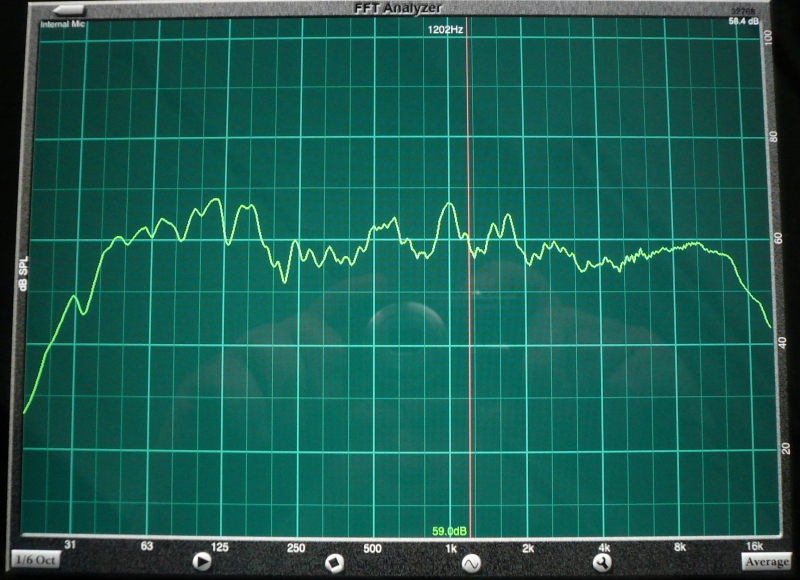
Measured via iPad, pink noise played on the system, 1/6th octave smoothing.
So ignore the highest and lowest frequencies (the iPad Mike is not very good for that), also be aware that measuring a stereo pair will create comb filtering...
The room is around 100sqm and full of shelves. This graph below is an attempt to scale the FR for an approximate comparison with the Stereophile Graphs referenced later.
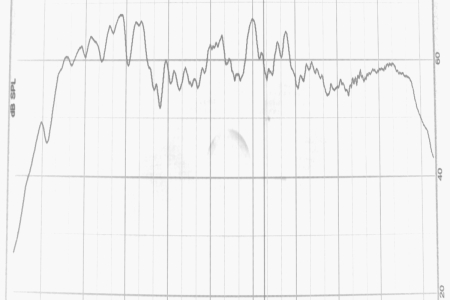
The measured response compares poorly with the common 1m, single speaker, anechoic or pseudo anechoic measurements.
A good comparison would be the in room responses JA publishes for some speakers in Stereophile, however unlike my one these are spatially averaged and only one speaker, so look smoother...
The two below are respectively:
Wilson Audio MAXX (blue) and Magico Q5 (red)
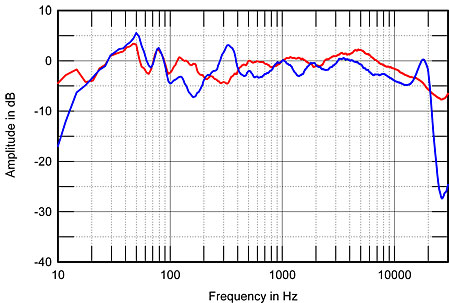
Audio Note E Lexus (blue) and Voxativ Ampeggio (red)
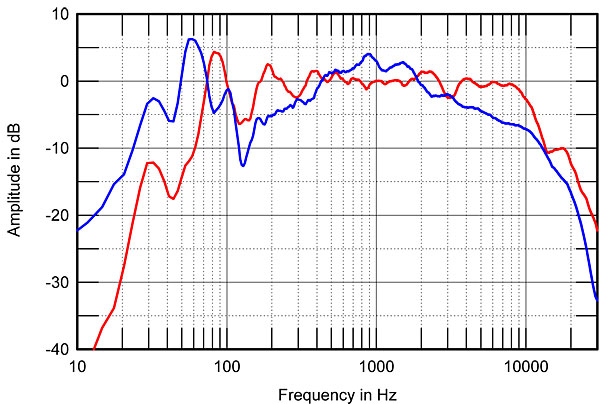
Ciao T
I just found a in room, stereo pair measured response at 3m distance.
Measured via iPad, pink noise played on the system, 1/6th octave smoothing.
So ignore the highest and lowest frequencies (the iPad Mike is not very good for that), also be aware that measuring a stereo pair will create comb filtering...
The room is around 100sqm and full of shelves. This graph below is an attempt to scale the FR for an approximate comparison with the Stereophile Graphs referenced later.
The measured response compares poorly with the common 1m, single speaker, anechoic or pseudo anechoic measurements.
A good comparison would be the in room responses JA publishes for some speakers in Stereophile, however unlike my one these are spatially averaged and only one speaker, so look smoother...
The two below are respectively:
Wilson Audio MAXX (blue) and Magico Q5 (red)

Audio Note E Lexus (blue) and Voxativ Ampeggio (red)

Ciao T
Attachments
- Status
- This old topic is closed. If you want to reopen this topic, contact a moderator using the "Report Post" button.
- Home
- DIY HiFi Supply
- Crescendo: Eureka! 100db from a 30L Cabinet - 65hz to 25khz
